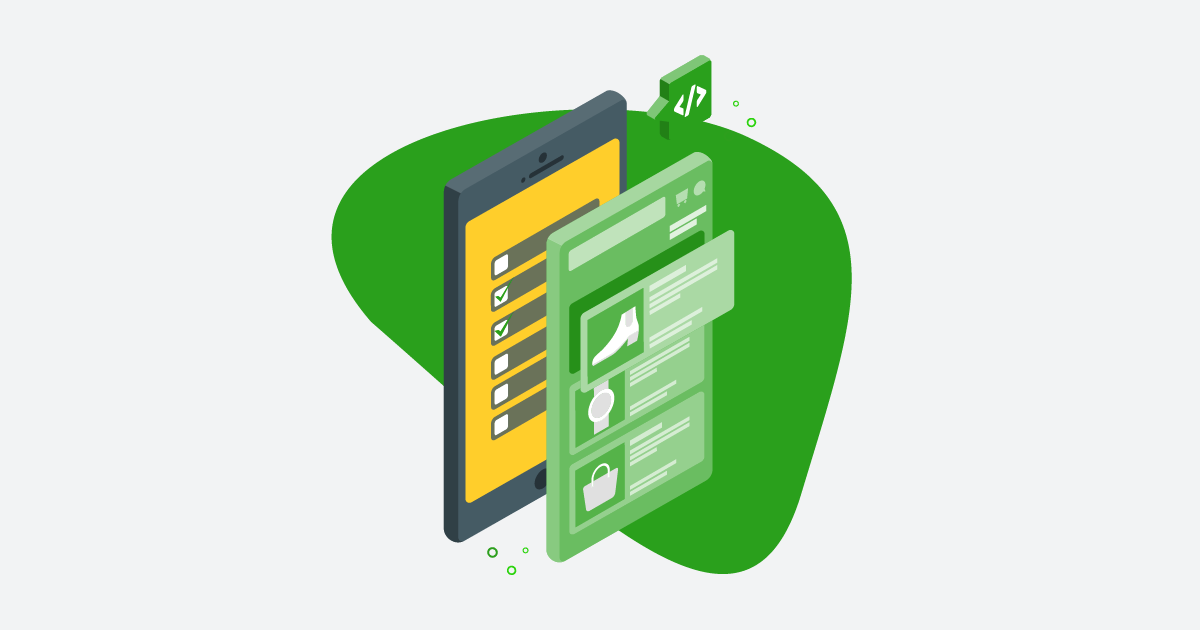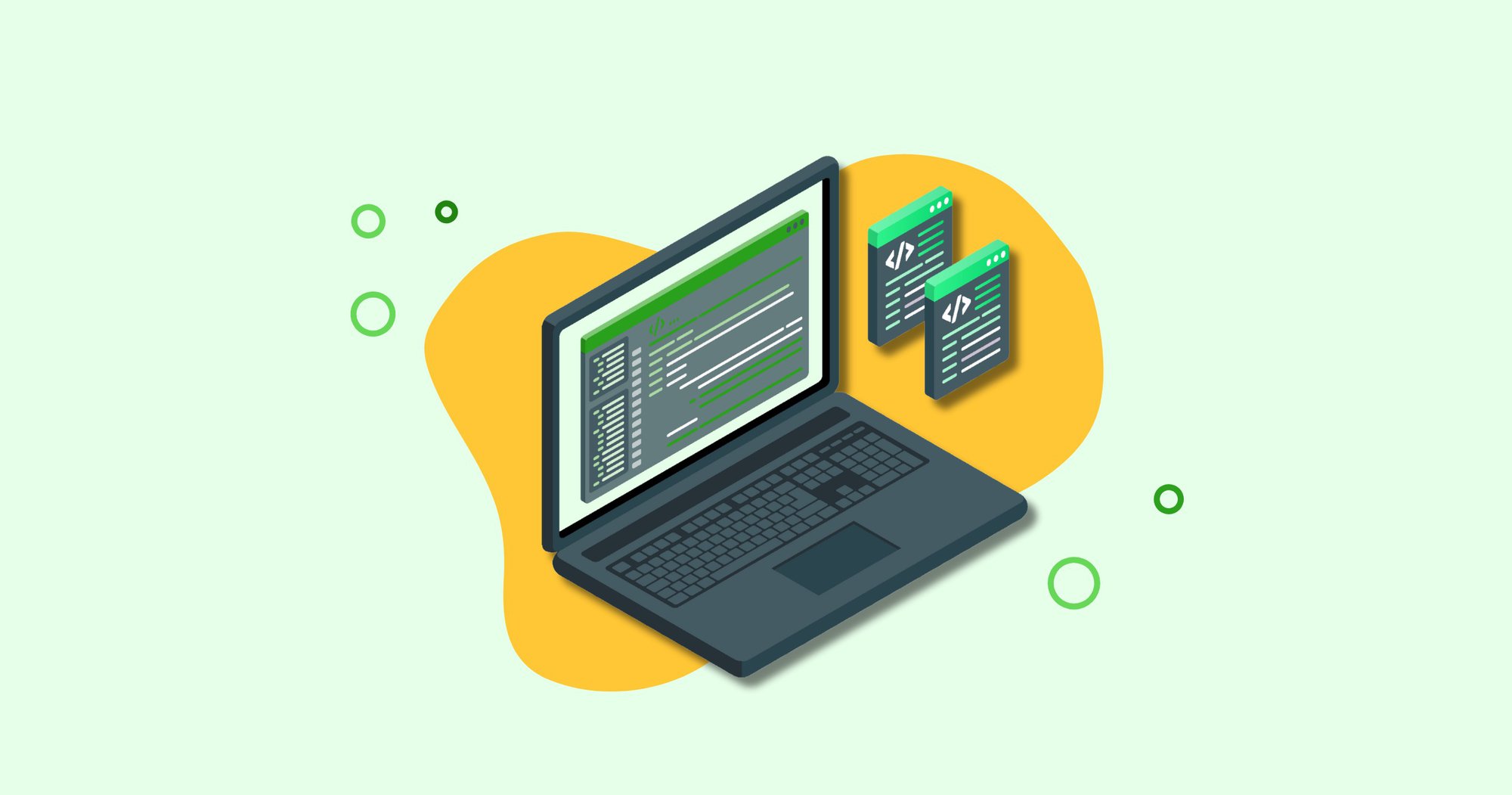Have you ever wondered why your ecommerce site isn’t ranking as well as you’d like despite having great products?
One of the sneaky culprits could be your product filtering and navigation, also known as your product taxonomy. When product filters and navigation systems aren’t optimized for SEO, they can slow down your site, confuse search engines, and even hurt your site’s visibility.
In this ecommerce SEO blog, we’ll explain the importance of product taxonomy and how unoptimized filters can impact your SEO. We’ll also explore the most common filtering and navigation systems and show you how to fix these issues for better SEO performance.
What is Product Taxonomy?
Before we go deep into the topic, let’s start with the basics.
The word taxonomy comes from the Greek word taxis, which means arrangement. In ecommerce websites, product taxonomy is simply how products are categorized, classified, and organized on your online store.
This includes everything from the main categories and subcategories, such as Women’s Clothing > Dresses, to more granular filters like price, size, and color.
A well-structured product taxonomy enhances customers’ shopping experiences and enables search engines to crawl and index your site more efficiently. However, poorly designed ecommerce product filters can generate thousands of unnecessary URL variations. Consequently, it overloads search engines and causes SEO problems, such as wasted crawl budget, duplicate content, and slow site performance.
5 Types of Product Taxonomy (Filtering and Navigation Systems)
Now that we understand product taxonomy, let’s look at some types of product filtering and navigation systems that are commonly used on ecommerce websites.
1. Drop-Down Menus
These are standard navigation options at the top of a webpage, where subcategories drop down when you hover over a main category. Drop-downs are simple, clean, and user-friendly.
For example, Indigo, an online bookstore, uses drop-down menus with several high-level categories. Hovering over “Books” reveals a submenu with options like new releases and bestsellers.
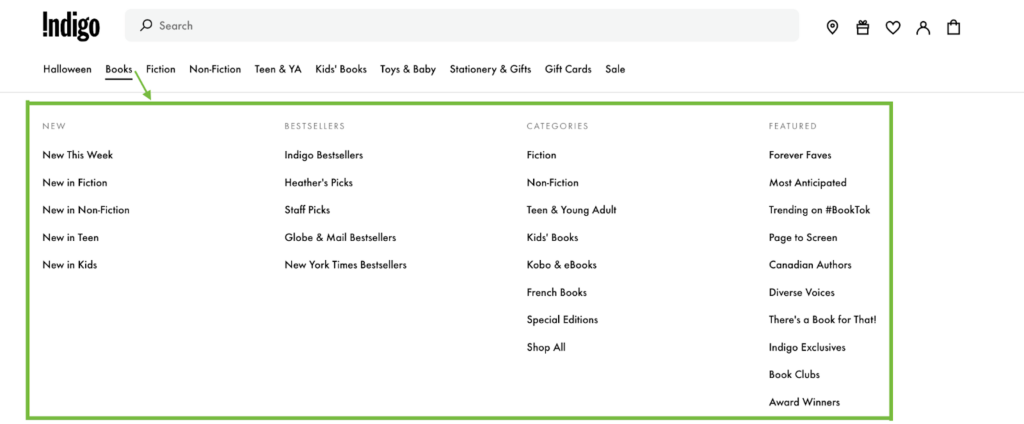
2. Horizontal Navigation
Horizontal navigation refers to links arranged in a row at the top of a website. Unlike drop-down menus, no additional options appear when you hover over a link. This type of navigation works well for smaller ecommerce sites with fewer pages to organize.
For example, Warby Parker uses a simple horizontal menu to direct shoppers to key product categories and site pages.
3. Faceted Search
This ecommerce product navigation system is especially useful for stores with large product inventories. It allows customers to filter products by multiple attributes at once, such as choosing color, size, and price filter options.
Take a look at the Nike website. Nike’s faceted search lets shoppers narrow down options based on various criteria, such as gender, color, and price range.
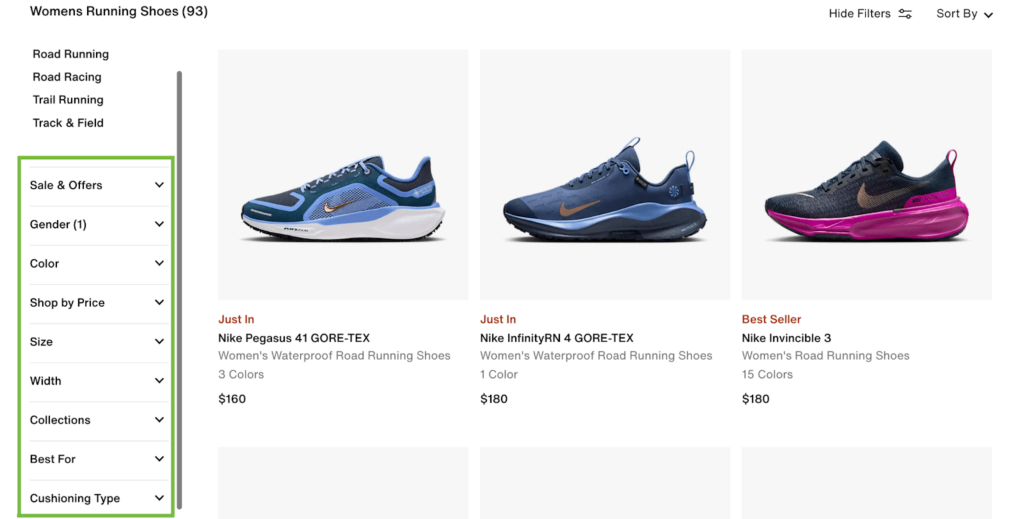
4. Sidebar Navigation
Sidebar navigation is compact and suitable for online stores that host many product categories. It allows you to display more top-level links without overwhelming users.
For example, Kohl’s uses the sidebar navigation with expandable categories to help customers easily explore their product range. By clicking the hamburger icon paired with “Shop by Category” text, shoppers can access the full menu.
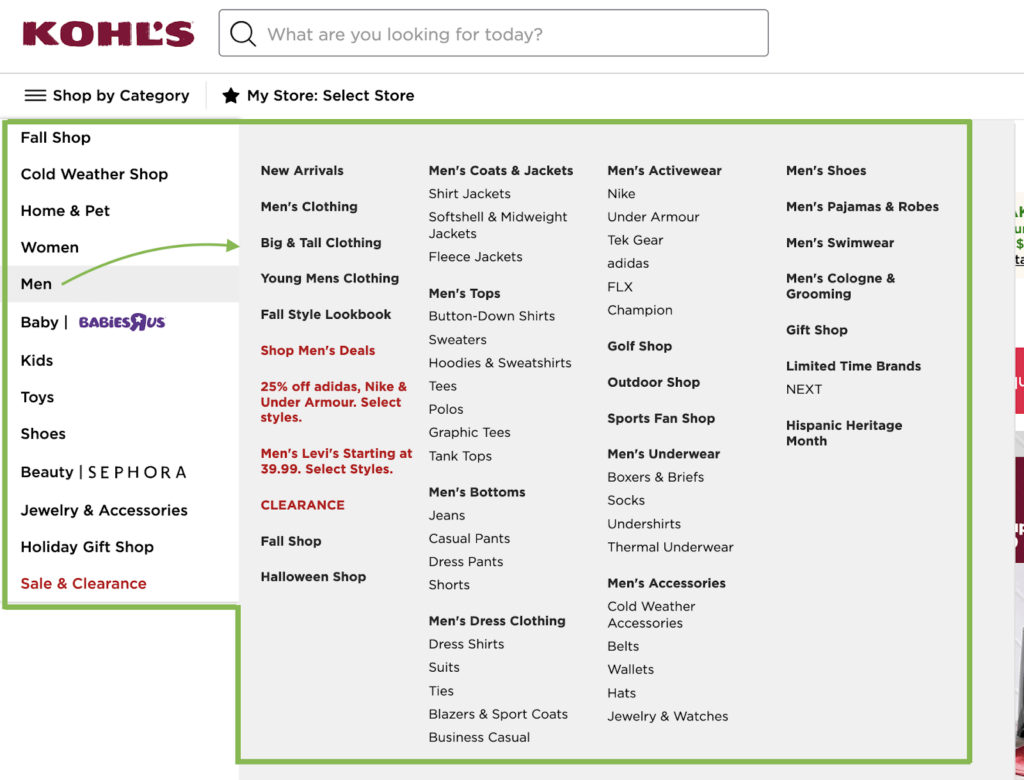
5. Breadcrumbs
Breadcrumbs display the path a user has taken through a site and are often located at the top of a website or just under the navigation bar.
They enhance both user experience and SEO by helping users easily navigate back to previous pages and creating internal links that help search engines efficiently crawl and understand your site’s structure.
For example, Adidas uses breadcrumbs to show the navigation trail while customers browse their product categories.

The Negative Impacts of Unoptimized Product Filters and Navigation on SEO
While these product filters and navigation systems are essential for enhancing user experience, they can also harm your SEO if not optimized. Here are some of the most common SEO issues caused by poor product filters and navigation setups.
A. Wasted Crawl Budget
Every website has a limited crawl budget, meaning search engines can only crawl a certain number of pages within a specific time frame. For large ecommerce sites with thousands of products, unoptimized filters can lead to an explosion of URLs—many of which add little to no SEO value.
Every time a user applies a filter, a new URL is generated. If not properly managed, these URLs can quickly create hundreds of near-identical pages, all competing for the same crawl budget. As a result, search engine crawlers end up wasting time and valuable crawl budget on these redundant pages instead of focusing on your product and category pages that move your bottom line.
In a bigger scope, not only does this inefficient crawl budget management leave your most valuable pages invisible to search engines, but it can slow down your indexing process and give Google negative signals about your web performance,
B. Poor Content Quality and Indexing Issues
Every time a new URL is generated from a product filter, search engines treat it as a new page. This can result in duplicate content and index bloat, where an excessive number of low-value pages get indexed, pushing out your important pages.
Another common problem is thin content, which refers to any page that doesn’t offer enough information to satisfy search intent and search engine quality standards. Since Google prioritizes quality, it tends to devalue or deindex thin content, further reducing your site’s SEO visibility.
Related: 5 Most Common Google Indexing Issues on Large Websites
C. Poor SEO Performance
Search engines rely on a combination of signals, such as backlinks, traffic, and user engagement, to decide which pages deserve higher rankings on SERPs.
However, when unoptimized filters generate multiple near-duplicate pages, these signals get diluted. Instead of concentrating authority on a single, canonical page, the signals are spread thinly across several URLs.
This signal distribution weakens the strength of your core pages, making it harder for them to rank competitively in search results and leading to less organic traffic.
D. Slow Site Speed
Many ecommerce sites use JavaScript to power dynamic filters and navigation systems, offering users interactive and customizable experiences. If these dynamic filters are not properly optimized, they can cause significant delays in page rendering, which can be detrimental to JS SEO optimization and overall site performance.
Left untreated, this slow speed can frustrate users and lead to higher bounce rates. Since page speed is a Google ranking factor, a slow site can hurt your SEO performance, leading to lower rankings and reduced visibility in search results.
E. Poor User Experience
Shoppers expect fast and seamless navigation, especially with large product catalogs. Unfortunately, poorly optimized filters can cause slow page loads, inconsistent search results, or broken filters, frustrating customers and leading to lost sales.
Since search engines closely monitor user behavior, increasing bounce rate or decreasing time on site signals to Google that your site is delivering a poor user experience. This can lead to lower rankings as Google favors and prioritizes sites that offer a seamless and engaging user experience.
How to Fix Unoptimized Product Taxonomy for Better SEO
Here are six effective solutions to address unoptimized product filters and navigation systems, especially for ecommerce sites.
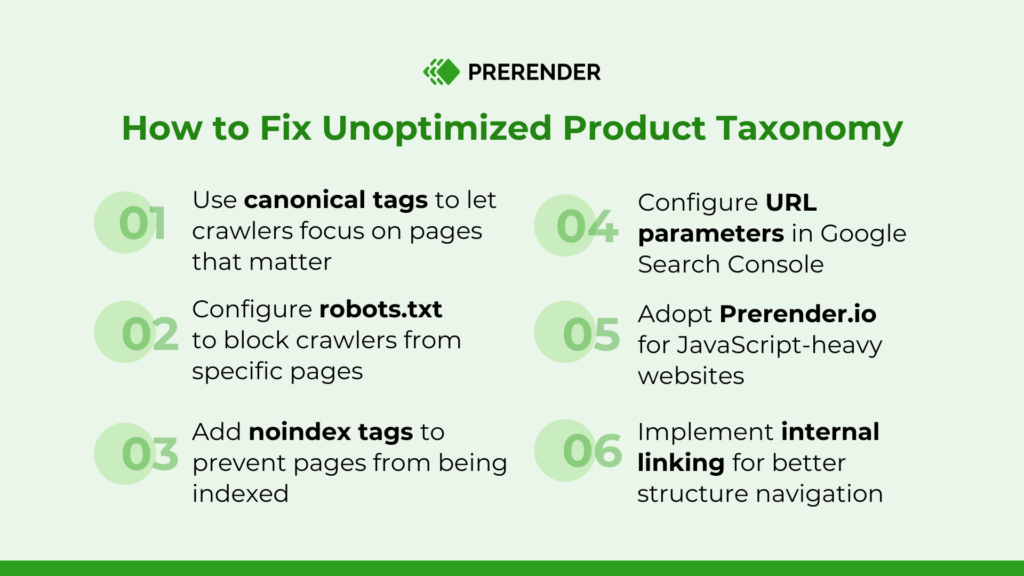
1. Add Canonical Tags to Avoid Duplicate Content
Canonical tags are HTML elements that indicate the “preferred” or “canonical” version of a page.
By using canonical tags, you “merge” the SEO value of duplicate pages and ensure that search engines focus on ranking the most authoritative version of the product page.
For example, you can place a canonical tag on filter-generated pages that don’t add significant value, pointing back to the main category page. This preserves the link equity of the main page and avoids unnecessary duplicates in search results while still allowing relevant, unique filters to be indexed when needed.
2. Robots.txt to Block Unnecessary Pages From Crawlers
A robots.txt file is helpful for SEO in that it instructs crawlers to index the most relevant pages, such as product categories or top-selling items, while filtered combinations that add little SEO value are ignored.
By specifying in your robots.txt file which URLs or URL parameters are off-limits to crawlers (e.g., /filter/color/), you help preserve the crawl budget for your priority pages.
For more practical tips on leveraging this method, check out our robots.txt guide for general websites and this tutorial for robots.txt tips for ecommerce websites. Each tip is easy to follow, but we highly suggest working with a technical SEO expert to implement and manage your site’s robots.txt file efficiently.
3. Add Noindex Tags to Prevent Pages from Being Indexed
While robots.txt blocks crawlers from accessing certain pages altogether, noindex tags allow pages to be crawled but prevent them from being indexed. This is particularly useful for filter-generated pages that are valuable for users but not necessarily worth indexing.
For instance, filters that display out-of-stock products, clearance items, or items in certain price ranges may not contribute much to SEO due to their temporary relevance.
By placing a noindex tag on these pages, crawlers will still crawl them for discovery purposes (for internal linking), but they won’t appear in search results.

This strategy keeps your site’s index clean and focused on high-value pages, improving your site’s quality and relevance in search results.
4. Configure URL Parameters in Google Search Console
Google Search Console offers a feature for managing how URL parameters should be treated during crawling. This feature allows you to:
- Tell Google whether certain parameters change the page’s content meaningfully or not
- Specify whether Google should crawl different parameter combinations or ignore them
For example, you may want to configure GSC to ignore parameters like ‘sort=price,’ which doesn’t change the page’s core content. This would reduce unnecessary crawls and improve your site’s SEO performance.
5. Adopt Prerender.io for JavaScript-Heavy Pages
Googlebot has improved its JavaScript rendering capabilities. However, it still struggles with dynamic content and takes longer to crawl JS-heavy sites, which impacts overall JS site speed optimization.
Prerender.io, a pre-rendering SEO solution, generates static HTML snapshots of JS pages, making them fully crawlable and indexable by search engines. When a crawler visits your page, Prerender serves the pre-rendered HTML version instead of relying on the search engine to process the JS.
By integrating Prerender.io, you ensure that your dynamic pages are rendered in a format that search engines can easily crawl, ultimately enhancing SEO for dynamic URLs. This approach improves your site’s speed, discoverability, indexing, and ranking efficiency.
Want to learn more about Prerender.io, JavaScript SEO, or pre-rendering in general? Check out our dedicated FAQs page.
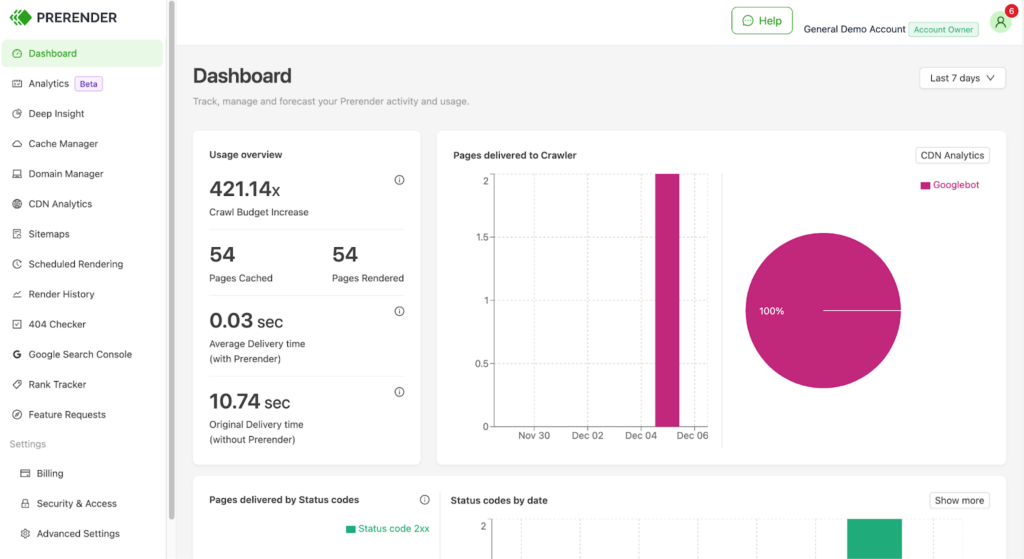
6. Implement Internal Linking for Better Structure Navigation
When product filters generate multiple URLs, it’s essential to ensure that internal links don’t direct crawlers (or users) to low-value or duplicate filter pages. Instead, focus your internal linking structure on promoting primary categories, best-selling products, and key landing pages that are vital for SEO success.
You can, for example, link to high-priority category pages from your homepage or main navigation to ensure that search engines efficiently crawl your site’s most important content. By creating a hierarchy where primary categories and product pages receive the most link equity, you improve your site’s ability to pass SEO signals to critical pages.
Adopt Prerender.io to Increase Your Ecommerce SEO Health
From managing the crawl budget to improving site speed, optimizing product filters and navigation systems is crucial for driving organic traffic and enhancing user experience on your ecommerce websites. Applying solutions such as robots.txt, canonical tags, and noindex tags can help, but it takes a lot of manual effort and repeated work.
For a more sustainable solution to improve your product taxonomy and its subsequent technical SEO performance, adopt Prerender.io.
Prerender.io ensures that all your product pages, filters, and categories, even those powered by JavaScript, are fully accessible, crawlable, and readily indexable by search engines without compromising SEO. By improving crawlability and indexing with Prerender, your site will be better positioned to rank for relevant queries, drive organic traffic, and convert visitors into customers.
Want to see how Prerender.io helped increase an ecommerce shop’s organic traffic by 50% through better JS indexing and crawling performance? This case study will tell you all the details.
When you’re ready to try Prerender.io, sign up here to get 1,000 FREE renders.
